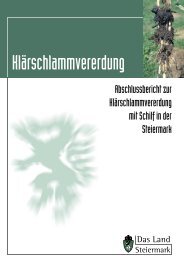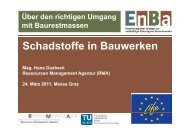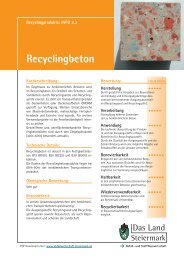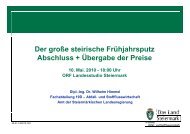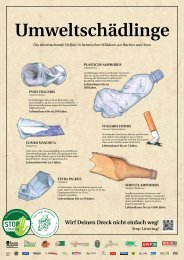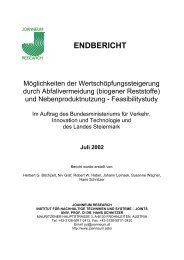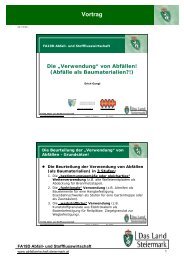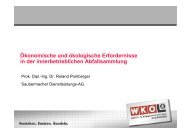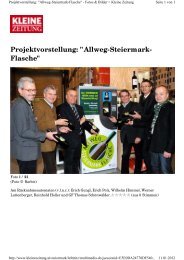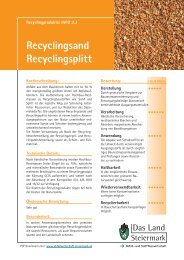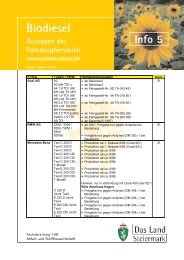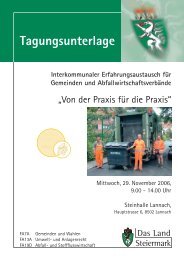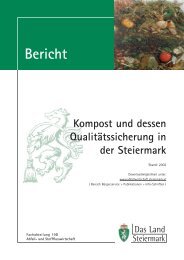Provincial Waste Management Plan Styria - Abfallwirtschaft - Abfall ...
Provincial Waste Management Plan Styria - Abfallwirtschaft - Abfall ...
Provincial Waste Management Plan Styria - Abfallwirtschaft - Abfall ...
You also want an ePaper? Increase the reach of your titles
YUMPU automatically turns print PDFs into web optimized ePapers that Google loves.
<strong>Provincial</strong> <strong>Waste</strong> <strong>Management</strong> <strong>Plan</strong> <strong>Styria</strong> - 2005<br />
In the public interest of sustainable waste and material flow management the collection, storage,<br />
transport, and treatment of waste pursuant to § 1 para. 3 AWG 2002 is required if otherwise<br />
• human health could be at risk or exposed to unacceptable disturbances,<br />
• natural living conditions of animals or plants and soil quality could be in danger,<br />
• a sustainable use of water and soil could be impaired,<br />
• the environment could be polluted beyond the inevitable degree,<br />
• there could be a risk of fire or explosion,<br />
• sounds or noise could be created in excessive dimensions,<br />
• the occurrence or growth of pathogenic agents could be favoured,<br />
• public order and safety could be disturbed, or<br />
• natural scenery or the appearance of settlements could be seriously damaged.<br />
In § 9 AWG 2002 the following targets are defined for a sustainable prevention of waste:<br />
• Products shall be long-lasting and easy to repair so that they can be recycled or recovered to<br />
a large extent after the end of their intended usage.<br />
• Distribution forms shall be organized in such a way that the waste volumes generated are as<br />
low as possible (e.g. by deposit systems).<br />
• Products shall be designed in such a way that the waste volumes generated during their<br />
production, use, and consumption are minimized and that the pollutant levels in waste are as<br />
low as possible.<br />
• Products shall be consumed in such a way that the environmental impact is minimized, in<br />
particular in terms of waste generation.<br />
A large number of national regulations have been passed on the basis of the guidelines defined in<br />
AWG 2002. Thereby, the legislative competence with regard to hazardous waste remains with the<br />
Federal State. In the case of non-hazardous waste, the Federal State is only competent if the adoption<br />
of uniform regulations is required. The Federal Minister for Agriculture, Forestry, Environment, and<br />
Water <strong>Management</strong> has made comprehensive use of the Bedarfsgesetzgebungskompetenz when<br />
adopting regulations on the legal basis of Art. 10 para. 1 N. 12 Federal Constitutional Law (e.g.<br />
packaging waste, biogenic waste, demolition and construction waste, end-of-life vehicles, and waste<br />
electrical and electronic equipment). Hence, the responsibility of the Federal Provinces with regard to<br />
non-hazardous waste has been strongly limited.<br />
2.1.6 Landfill Ordinance 1996 10<br />
The prohibition of the landfilling of waste that contains a weight percentage of organic carbon higher<br />
than 5 resulted in significant changes in the field of waste management. Among others, wastes from<br />
mechanical-biological pre-treatment are excluded from this landfill prohibition if their heat of<br />
combustion (gross calorific value) - related to dry matter - does not exceed 6,600 kJ/kg ("Heat of<br />
combustion criterion" according to Appendix 5 section G). Additionally, the stability criteria according<br />
to Appendix 1 Table 8 of the Landfill Ordinance must be respected for waste that has undergone<br />
mechanical-biological pre-treatment.<br />
10 Federal Law Gazette No. 164/1996 as amended in Federal Law Gazette No. II No. 49/2004<br />
Page 13



